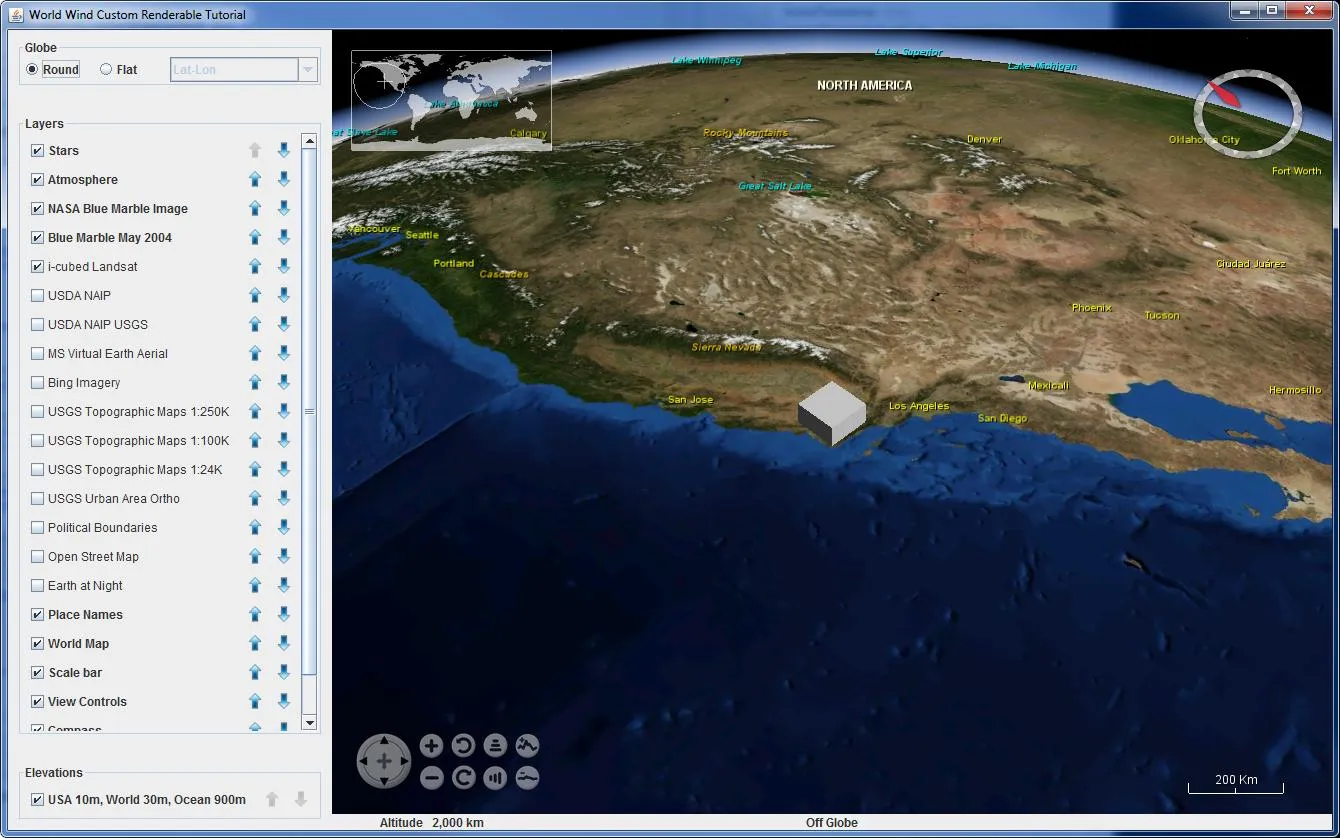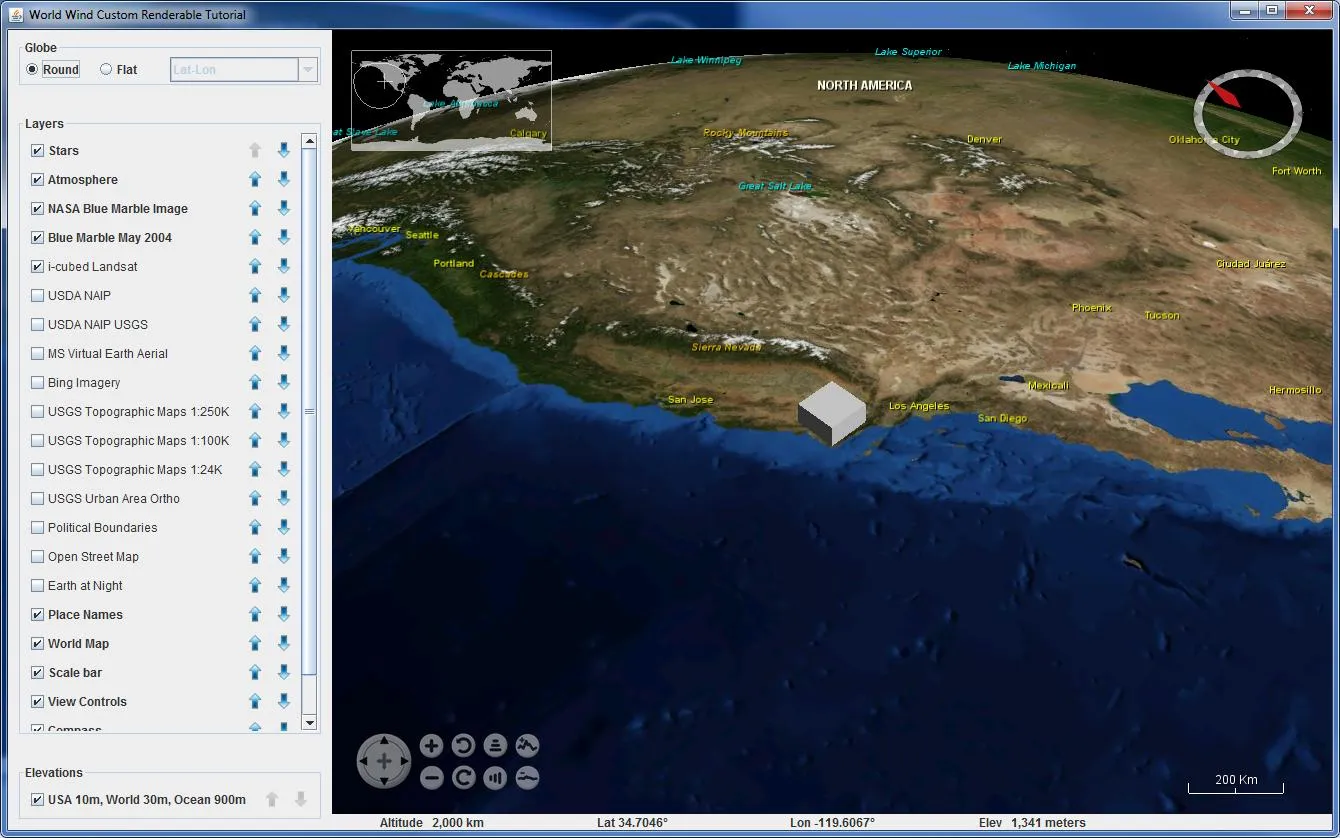我正在学习这个教程
每当我的鼠标悬停在使用这段代码创建的立方体上时(下面是我的版本),大气层和星星就会消失。
这是正常情况下的外观:
这是当我将鼠标悬停在立方体上时的外观(请注意大气层):
我不确定这里发生了什么。
/*
* Copyright (C) 2012 United States Government as represented by the Administrator of the
* National Aeronautics and Space Administration.
* All Rights Reserved.
*/
package gov.nasa.worldwindx.examples.tutorial;
import gov.nasa.worldwind.Configuration;
import gov.nasa.worldwind.avlist.AVKey;
import gov.nasa.worldwind.geom.*;
import gov.nasa.worldwind.layers.RenderableLayer;
import gov.nasa.worldwind.pick.PickSupport;
import gov.nasa.worldwind.render.*;
import gov.nasa.worldwind.util.OGLUtil;
import gov.nasa.worldwindx.examples.ApplicationTemplate;
import javax.media.opengl.*;
import java.awt.*;
/**
* Example of a custom {@link Renderable} that draws a cube at a geographic position. This class shows the simplest
* possible example of a custom Renderable, while still following World Wind best practices. See
* http://goworldwind.org/developers-guide/how-to-build-a-custom-renderable/ for a complete description of this
* example.
*
* @author pabercrombie
* @version $Id: Cube.java 691 2012-07-12 19:17:17Z pabercrombie $
*/
public class Cube extends ApplicationTemplate implements Renderable
{
/** Geographic position of the cube. */
protected Position position;
/** Length of each face, in meters. */
protected double size;
/** Support object to help with pick resolution. */
protected PickSupport pickSupport = new PickSupport();
// Determined each frame
protected long frameTimestamp = -1L;
protected OrderedCube currentFramesOrderedCube;
/**
* This class holds the Cube's Cartesian coordinates. An instance of it is added to the scene controller's ordered
* renderable queue during picking and rendering.
*/
protected class OrderedCube implements OrderedRenderable
{
/** Cartesian position of the cube, computed from
* {@link gov.nasa.worldwindx.examples.tutorial.Cube#position}. */
protected Vec4 placePoint;
/** Distance from the eye point to the cube. */
protected double eyeDistance;
/**
* The cube's Cartesian bounding extent.
*/
protected Extent extent;
public double getDistanceFromEye()
{
return this.eyeDistance;
}
public void pick(DrawContext dc, Point pickPoint)
{
// Use same code for rendering and picking.
this.render(dc);
}
public void render(DrawContext dc)
{
Cube.this.drawOrderedRenderable(dc, Cube.this.pickSupport);
}
}
public Cube(Position position, double sizeInMeters)
{
this.position = position;
this.size = sizeInMeters;
}
public void render(DrawContext dc)
{
// Render is called twice, once for picking and once for rendering. In both cases an OrderedCube is added to
// the ordered renderable queue.
OrderedCube orderedCube = this.makeOrderedRenderable(dc);
if (orderedCube.extent != null)
{
if (!this.intersectsFrustum(dc, orderedCube))
return;
// If the shape is less that a pixel in size, don't render it.
if (dc.isSmall(orderedCube.extent, 1))
return;
}
// Add the cube to the ordered renderable queue. The SceneController sorts the ordered renderables by eye
// distance, and then renders them back to front.
dc.addOrderedRenderable(orderedCube);
}
/**
* Determines whether the cube intersects the view frustum.
*
* @param dc the current draw context.
*
* @return true if this cube intersects the frustum, otherwise false.
*/
protected boolean intersectsFrustum(DrawContext dc, OrderedCube orderedCube)
{
if (dc.isPickingMode())
return dc.getPickFrustums().intersectsAny(orderedCube.extent);
return dc.getView().getFrustumInModelCoordinates().intersects(orderedCube.extent);
}
/**
* Compute per-frame attributes, and add the ordered renderable to the ordered renderable list.
*
* @param dc Current draw context.
*/
protected OrderedCube makeOrderedRenderable(DrawContext dc)
{
// This method is called twice each frame: once during picking and once during rendering. We only need to
// compute the placePoint, eye distance and extent once per frame, so check the frame timestamp to see if
// this is a new frame. However, we can't use this optimization for 2D continuous globes because the
// Cartesian coordinates of the cube are different for each 2D globe drawn during the current frame.
if (dc.getFrameTimeStamp() != this.frameTimestamp || dc.isContinuous2DGlobe())
{
OrderedCube orderedCube = new OrderedCube();
// Convert the cube's geographic position to a position in Cartesian coordinates. If drawing to a 2D
// globe ignore the shape's altitude.
if (dc.is2DGlobe())
{
orderedCube.placePoint = dc.getGlobe().computePointFromPosition(this.position.getLatitude(),
this.position.getLongitude(), 0);
}
else
{
orderedCube.placePoint = dc.getGlobe().computePointFromPosition(this.position);
}
// Compute the distance from the eye to the cube's position.
orderedCube.eyeDistance = dc.getView().getEyePoint().distanceTo3(orderedCube.placePoint);
// Compute a sphere that encloses the cube. We'll use this sphere for intersection calculations to determine
// if the cube is actually visible.
orderedCube.extent = new Sphere(orderedCube.placePoint, Math.sqrt(3.0) * this.size / 2.0);
// Keep track of the timestamp we used to compute the ordered renderable.
this.frameTimestamp = dc.getFrameTimeStamp();
this.currentFramesOrderedCube = orderedCube;
return orderedCube;
}
else
{
return this.currentFramesOrderedCube;
}
}
/**
* Set up drawing state, and draw the cube. This method is called when the cube is rendered in ordered rendering
* mode.
*
* @param dc Current draw context.
*/
protected void drawOrderedRenderable(DrawContext dc, PickSupport pickCandidates)
{
this.beginDrawing(dc);
try
{
GL2 gl = dc.getGL().getGL2(); // GL initialization checks for GL2 compatibility.
if (dc.isPickingMode())
{
Color pickColor = dc.getUniquePickColor();
pickCandidates.addPickableObject(pickColor.getRGB(), this, this.position);
gl.glColor3ub((byte) pickColor.getRed(), (byte) pickColor.getGreen(), (byte) pickColor.getBlue());
}
// Render a unit cube and apply a scaling factor to scale the cube to the appropriate size.
gl.glScaled(this.size, this.size, this.size);
this.drawUnitCube(dc);
}
finally
{
this.endDrawing(dc);
}
}
/**
* Setup drawing state in preparation for drawing the cube. State changed by this method must be restored in
* endDrawing.
*
* @param dc Active draw context.
*/
protected void beginDrawing(DrawContext dc)
{
GL2 gl = dc.getGL().getGL2(); // GL initialization checks for GL2 compatibility.
int attrMask = GL2.GL_CURRENT_BIT | GL2.GL_COLOR_BUFFER_BIT;
gl.glPushAttrib(attrMask);
if (!dc.isPickingMode())
{
dc.beginStandardLighting();
gl.glEnable(GL.GL_BLEND);
OGLUtil.applyBlending(gl, false);
// Were applying a scale transform on the modelview matrix, so the normal vectors must be re-normalized
// before lighting is computed.
gl.glEnable(GL2.GL_NORMALIZE);
}
// Multiply the modelview matrix by a surface orientation matrix to set up a local coordinate system with the
// origin at the cube's center position, the Y axis pointing North, the X axis pointing East, and the Z axis
// normal to the globe.
gl.glMatrixMode(GL2.GL_MODELVIEW);
Matrix matrix = dc.getGlobe().computeSurfaceOrientationAtPosition(this.position);
matrix = dc.getView().getModelviewMatrix().multiply(matrix);
double[] matrixArray = new double[16];
matrix.toArray(matrixArray, 0, false);
gl.glLoadMatrixd(matrixArray, 0);
}
/**
* Restore drawing state changed in beginDrawing to the default.
*
* @param dc Active draw context.
*/
protected void endDrawing(DrawContext dc)
{
GL2 gl = dc.getGL().getGL2(); // GL initialization checks for GL2 compatibility.
if (!dc.isPickingMode())
dc.endStandardLighting();
gl.glPopAttrib();
}
/**
* Draw a unit cube, using the active modelview matrix to orient the shape.
*
* @param dc Current draw context.
*/
protected void drawUnitCube(DrawContext dc)
{
// Vertices of a unit cube, centered on the origin.
float[][] v = {{-0.5f, 0.5f, -0.5f}, {-0.5f, 0.5f, 0.5f}, {0.5f, 0.5f, 0.5f}, {0.5f, 0.5f, -0.5f},
{-0.5f, -0.5f, 0.5f}, {0.5f, -0.5f, 0.5f}, {0.5f, -0.5f, -0.5f}, {-0.5f, -0.5f, -0.5f}};
// Array to group vertices into faces
int[][] faces = {{0, 1, 2, 3}, {2, 5, 6, 3}, {1, 4, 5, 2}, {0, 7, 4, 1}, {0, 7, 6, 3}, {4, 7, 6, 5}};
// Normal vectors for each face
float[][] n = {{0, 1, 0}, {1, 0, 0}, {0, 0, 1}, {-1, 0, 0}, {0, 0, -1}, {0, -1, 0}};
// Note: draw the cube in OpenGL immediate mode for simplicity. Real applications should use vertex arrays
// or vertex buffer objects to achieve better performance.
GL2 gl = dc.getGL().getGL2(); // GL initialization checks for GL2 compatibility.
gl.glBegin(GL2.GL_QUADS);
try
{
for (int i = 0; i < faces.length; i++)
{
gl.glNormal3f(n[i][0], n[i][1], n[i][2]);
for (int j = 0; j < faces[0].length; j++)
{
gl.glVertex3f(v[faces[i][j]][0], v[faces[i][j]][1], v[faces[i][j]][2]);
}
}
}
finally
{
gl.glEnd();
}
}
protected static class AppFrame extends ApplicationTemplate.AppFrame
{
public AppFrame()
{
super(true, true, false);
RenderableLayer layer = new RenderableLayer();
Cube cube = new Cube(Position.fromDegrees(35.0, -120.0, 3000), 100000);
layer.addRenderable(cube);
getWwd().getModel().getLayers().add(layer);
}
}
public static void main(String[] args)
{
Configuration.setValue(AVKey.INITIAL_LATITUDE, 35.0);
Configuration.setValue(AVKey.INITIAL_LONGITUDE, -120.0);
Configuration.setValue(AVKey.INITIAL_ALTITUDE, 2550000);
Configuration.setValue(AVKey.INITIAL_PITCH, 45);
Configuration.setValue(AVKey.INITIAL_HEADING, 45);
ApplicationTemplate.start("World Wind Custom Renderable Tutorial", AppFrame.class);
}
}


dc.isPickingMode为true)。我猜这会影响SkyGradientLayer的渲染。也许这可以帮助您进行调试,同时 - 我可以重现此问题。我会在有时间时尝试解决它。 - J Richard Snapeworldwindx.jar捆绑的Cube类中。 由于他们的立方体比你的小得多,所以有点难以复制,但是如果您设置正确的视角(倾斜?),则可以做到。 我仍在研究为什么会发生这种情况。 - J Richard Snape